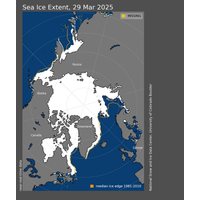
Arctic Sea Ice Hits Record Low Maximum Extent for the Year
Arctic sea ice has likely reached its maximum extent for the year, at 14.33 million square kilometers (5.53 million square miles) on March 22, according to scientists at the National Snow and Ice Data Center (NSIDC) at the University of Colorado Boulder.The 2025 maximum sea ice extent is the lowest in the 47-year satellite record, falling short of the previous record low of 14.41 million square kilometers (5.56 million square miles) set on March 7, 2017.“This new record low is yet another indicator of how Arctic sea ice has fundamentally changed from earlier decades,” said NSIDC senior
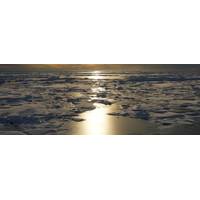
An Arctic “Beyond Recognition” Expected by 2100
paper, published in Science on February 6, 2025, highlights the expected changes to the Arctic, the fastest-warming region on Earth. The paper, “Disappearing landscapes: The Arctic at +2.7°C global warming,” was led by Julienne Stroeve, senior research scientist at the National Snow and Ice Data Center (NSIDC) and professor at the Centre for Earth Observation Science at the University of Manitoba.“The Arctic is warming at four times the rate of the rest of the planet,” said Stroeve. “At 2.7 degrees Celsius of global warming, we will see more extreme and cascading
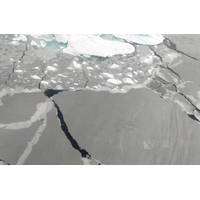
Arctic Sea Ice Could Reach Turning Point by 2027
; from the University of Gothenburg in Sweden. The team used computer models to predict when the first ice-free day could occur in the northernmost ocean.When the Arctic Ocean has less than 1 million square kilometers of ice, scientists say the Arctic is ice free.In September, the National Snow and Ice Data Center reported that this year’s Arctic sea ice minimum, the day with the least amount of frozen seawater in the Arctic, was one of the lowest on record since 1978.At 1.65 million square miles, or 4.28 million square kilometers, this year’s minimum was above the all-time low observed
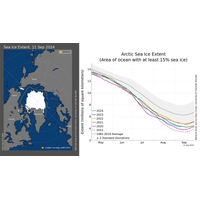
Arctic Sea Ice Reaches Seventh Lowest Extent on Record
Arctic sea ice has likely reached its minimum extent for the year, at 4.28 million square kilometers (1.65 million square miles) on September 11, 2024, according to scientists at the National Snow and Ice Data Center (NSIDC) at the University of Colorado Boulder.The 2024 minimum is ranked seventh lowest in the 46-year satellite record. The last 18 years are the lowest 18 Arctic sea ice extents in the satellite record.The overall, downward trend in the minimum extent from 1979 to 2024 is 12.4 percent per decade relative to the 1981 to 2010 average. From the linear trend, the loss of sea ice is about 77
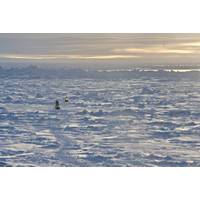
The Arctic: Scientists Aim to Improve Sea Ice Predictions' Accuracy, Access
gap between sea ice forecasting and stakeholder needs.”Bhatt’s AGU presentation is here.This chart shows distribution of the 36 sea ice outlook contributions for September estimates of the September 2021 monthly mean Arctic sea ice extent. Chart courtesy of Matthew Fisher, U.S. National Snow and Ice Data Center
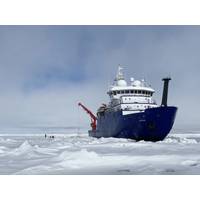
UAF’s GINA Provides a Guiding Hand in Arctic Ocean Research
Seth Danielson, chief scientistEyes in the SkyNavigating sea ice is a burgeoning field of interest as shipping increases in the Arctic, which is becoming increasingly open though not entirely ice-free. Icebergs from coastal sources still bob along, and thick slabs of sea ice still drift.The National Snow and Ice Data Center notes that satellites have only been continuously monitoring sea ice since 1979. Prior to that, captains had to rely on their crews’ firsthand observations and on weekly ice charts based on airborne observations and reports from observers on the coasts and other ships.Avoiding
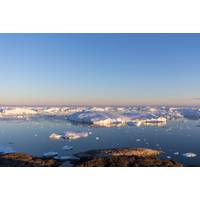
Arctic Warming Cascades Through Ocean and Over Land
;the day of the smallest extent of the year—compared to the median extent (gold line) reached on this date in Septembers from 1981 to 2010. (bottom) Annual maximum (dark blue) and minimum (light blue) ice extents from 1979 to 2020. Credit: NOAA Climate.gov, based on data from the National Snow and Ice Data Center and the 2020 Arctic Report Card."When the report card started 15 years ago, I wrote about how low it was then. But I’d trade that low for what we're seeing now any day," said co-author Donald Perovich, a sea ice geophysicist at Dartmouth University. The September
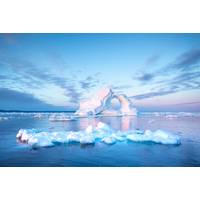
Arctic Sea Ice Lows Mark a New Polar Climate Regime
square kilometers – reached in September 2012 after a late-season cyclonic storm broke up the remaining ice – is not much below what we see today.“We haven’t gone back at all to anything from 30 to 40 years ago,” said climatologist Julienne Stroeve at the National Snow and Ice Data Center in Boulder, Colorado. And as climate change continues, scientists say the sea ice is unlikely to recover to past levels.In fact, the long-frozen region is already shifting to an entirely new climate regime, marked by the escalating trends in ice melt, temperature rise and rainfall days
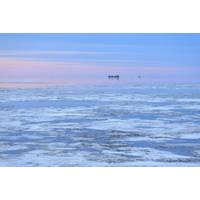
Winter Sea Ice in Bering Sea Reached Lowest Levels in Millennia
in the region, as ice is replaced by patches of dark water that absorb solar radiation rather than reflecting it back out of the atmsophere."Obviously, if we lose the sea ice you are completely changing the temperatures of the Arctic," said Julienne Stroeve, a climatologist with National Snow and Ice Data Center at the University of Boulder Colorado not involved in the study. "If you lose it all, you're going to warm up the region even faster."Air temperature wasn't the only factor found to be affecting sea ice, though. Shifts in ocean and atmospheric circulation linked to



 February 2025
February 2025





